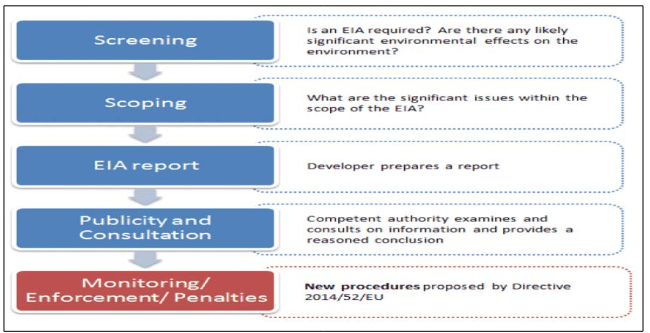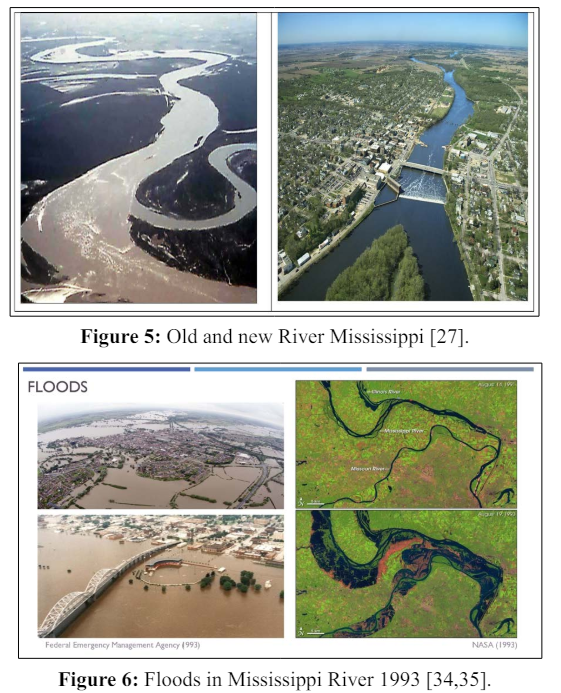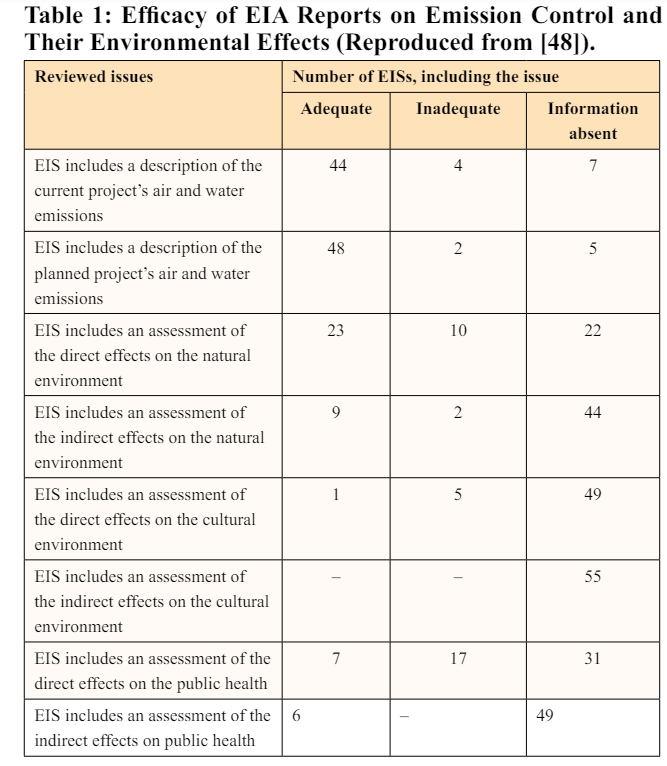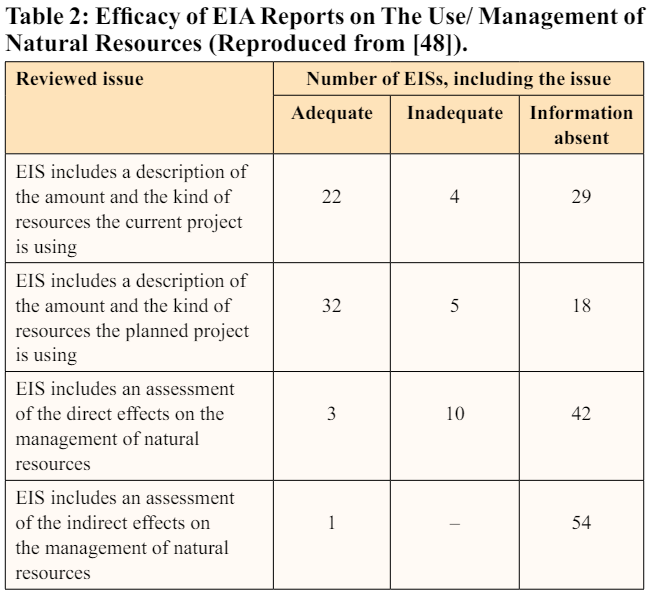Author(s): <p>Hafiz Muhammad Nadir*, Ash Ahmed</p>
The developed countries have been doing extraordinary marvels in science, technology and construction with a desire to tame nature coherently. This domination desire has negatively/ irreversibly impacted the environment. However, after generating enormous challenges to nature through uncontrolled developments, the developed countries started endeavouring to save the environment from the devastating impacts of construction projects at the end of the 20th century by incorporating the environmental impact assessment (EIA). EIA is the process of identifying, evaluating, and mitigating development projects' damaging environmental and social effects. In the last 25 years, EIA has developed into a mature system and is an effective tool for assessing, minimising and mitigating severe impacts of development projects on the environment. EIA is only an assessment tool to ascertain the damaging effects of projects on the environment and alternative proposals for their mitigation; however, the final decision rests with political authorities who may consider the EIA report or turn it down in the name of better interests of society/country. Unfortunately, EIA has not proved to be a fully effective process as the developed countries are still undertaking unobstructed/ unopposed mega development projects best conforming to their better interests, and developing countries are still far behind in the apprehension of the necessity of EIA. However, with the UN, USA and EU efforts, more than 120 countries have pledged to exercise EIA to assess development projects before their commencement. In this study, an endeavour has been made to review the necessity/ objectives of EIA, its historical evolutionary process, internationally recognised legal obligations, the stages of the EIA process based on the nature of projects, constraints/ pros and cons of the implementation of EIA process and efficacy of EIA as an intended tool to save the environment from the hazards of mega projects duly supported by three case studies of international projects in USA, Sweden and Pakistan.
The USA pioneered the spearhead lead in 1969 by officially promulgating the ?National Environmental Policy Act?. It incorporated environmental protection as the government's responsibility, incorporating the legal authority for the regulators to repudiate a project if considered an anthropogenic environmental hazard [1]. The Stockholm conference in 1972 enlightened/ commenced the world's attention to the environmental consequences of inadvertent development [2]. The UN summit on environment and development (UNCED), also termed the 1992’s Rio de Janeiro convention, took the leading initiative in developing the binding concept of sustainable development by considering EIA paraphernalia as a pre-planning requisite [3]. The major countries in the world are signatories to implementing the EIA as a process to identify the effects of anthropogenic activities on nature/ environment by any large project. The planning authorities widely accept EIA as an assessment tool to anticipate, identify, and mitigate mega projects' environmental impacts/ paradigms to ensure sustained development with minimum environmental repercussions [4]. "The International Association for Impact Assessment (IAIA)" was established in 1980 as a leading global policy-making forum on EIA. It has over 1,600 members representing all countries [5]. EU also followed the USA and proposed the first agreed regulations in 1985, which have been amended several times till the present-day form of the 2017 directive [6].
EU EIA directive comprises eight principles, i.e., participation, transparency, certainty, accountability, credibility, costeffectiveness, flexibility and practicality. These principles give complete discretion to experts to assess and evaluate the projects’ hazards with honesty and sincerity, make them accountable to law/ third parties audits and bequeath flexibility to competent governing/ political authority to accept/ reject the EIA plan based on practicality [7]. EU has issued several directives on EIA, with the latest in 2017 known as EU EIA Directive 2017 and binding on all member countries. UK has transformed this directive into EIA Regulations in ?Town and Country Planning Regulations 2017? for implementation in the UK [8].
The objective of EIA is to identify, assess and evaluate the environmental impact of development projects to provide information to local/ political authorities on the environmental consequences for their decision-making in a way to endorse secure and environmentally friendly development using suitable alternatives and mitigation processes.
EIA is considered a new process developed in the last 25 years with a false sense of an anti-development tool. Being an assessment tool only for the decision maker to decide the importance of projects versus the environmental aspects, EIA has several constraints in its implementation, which can mainly be attributed to the lack of understanding of EIA, lack of public participation, inadequate and uncertain data, knowledge gaps for prediction of future impacts, cost of EIA process (who will bear it and how it will be paid), doubtful effectiveness of EIA process to satisfy stakeholders, lack of influence of EIA on trans-border issues (like construction of dams on a trans-border river), complicated and time-consuming procedures in EIA especially the preparation of the technical report, and lack of adequacy in mitigation methods and weakness in litigation procedures [9].
Have elaborated in detail on the strengths, weaknesses, opportunities, and threats through SWOT analysis, questionnaire survey and opinion interviews on 25 years of the UK EIA system [10]. Their work has been summarised in figure 1, derived from the original assessment theme of [11]. In their opinion, the system's biggest strength is preventing anthropogenic hazards and the legal support provided by UK regulations. It has given developers and local/ national authorities a straightforward power to consider environmental impacts as essential as the financial/ social implications. The biggest weakness is that it is only a planning tool and needs to be given regulatory power; instead, it needs more cohesion with different regulations providing several escape loopholes to developers. EIA has many opportunities as having the potential of gross awareness and incorporation of advancement in the EIA process using the latest IT tools. However, discontinuity in practising EIA, implementation loopholes/ weaknesses, minimal public participation and the detestation attitude of developers towards EIA due to its cost, time, and anticipated modifications in original scope and litigations are the threats to effective EIA in the UK and worldwide [10].

Figure 1: 25 years of EIA in the UK: A SWOT analysis [10,11]
The EIA process comprises screening the projects as the first step to determine whether or not EIA is required, then scoping as step 2 to anticipate all issues to be considered for EIA, and a draft EIA report is prepared in step 3, which is then floated for public participation/ technical consultation in step 4. After concocting a detailed assessment of issues, different mitigation options are considered to formulate a final EIA statement or report. The political authority then uses this report to decide in favour or against the commencement of a project. When a decision has been constituted, then appropriate monitoring and auditing mechanism is implemented to ensure the contrivance to the EIA report in letter and spirit during the execution phase. The flow chart of the EIA process as per the is illustrated in figure 2 [12].

Figure 2: EIA Process [12]
Schedules of Projects Requiring EIA Reports (UK EIA Process) The UK EIA regulations have categorised the projects requiring EIA into two schedules (1 and 2) based on their nature. EIA is mandatory for Schedule 1 projects. For Schedule 2 projects, an EIA may/ may not be required considering the types of projects and their environmental impacts. Some examples of Schedule 1 are major power plants, chemical works, waste disposal incineration, and major road schemes. Examples of schedule 2 projects are quarries and opencast, deep drilling, surface industrial installations, some intensive agricultural farms/ factories, surface fossil fuel storage, foundries and forges, coke ovens, manufacturing of dairy products, brewing plants, some textile operations/ factories, rubber production, wastewater treatment plants, holiday villages, and golf courses [13, 8].
Schedule 3 gives guidelines for screening projects falling in schedule 2 to ascertain whether or not these require EIA. The characteristics of development, the location of projects and the potentially significant effects of development must be considered concerning the criteria for conducting the EIA process [13]
An EIA report has three parts: the planning application, the environmental statement and the technical report [13]. According to the latest directive on EIA in 2017, which is the continuation of the 2014 directive, conducting analyses for at least two alternatives for a project is now mandatory. The EIA process includes validating climatic impacts due to carbon emissions and adapting the proposed project to changing climate [14]. The resilience of any proposed project against any accident causing environmental damage is ascertained [15]. The requirement of emergency services related to projects should be assessed [16]. EIA directive requires the project to be evaluated on heritage aspect, archaeological disturbances, impacts on landscape, any disturbance to the reserved forest/ national parks sites and ecological health of sea/ water bodies, habitat, species and air pollution along with voluntary validation from the institute of environmental management & assessment (IEMA) [17, 18].
The EIA process contains a legal authority endorsed by all IAIA member countries to conduct an assessment before endeavouring to any major project. Over a period, it has gained significant importance, especially in developed countries. However, the effectiveness of EIA in comprehensively tackling the environmental issues arising from substantial development remains controversial [10]. while analysing 25 years of EIA in the UK, have assessed that slight improvements in internal factors of strength and weaknesses of EIA through the incorporation of IT tools have been achieved with increased linkage to external factors of opportunities in EIA since 1999 [10]. have elaborated that the influence of environmental pressure groups in implementing EIA has reduced, but consideration of socio-economics impacts has increased. have assessed that there are a lot of gaps/ inadequacies in the interpretation/ implementation of EIA regulations in the UK which give rise to the ineffectiveness of EIA [19]. EIA is still struggling to become a successful result-oriented/ impactspreventing tool against the hazards inflicted by mega projects like motorways, heavily modified water bodies, and modified land use, especially where the political interests of the UK or any other country are involved [17, 20].
Here are a few case studies from different countries which demonstrate the effectiveness of EIA, some with partial success about the influence of EIA and results from EIA.
Engineers have been endeavouring the channelisation of rivers worldwide to control the flow to prevent flood, sediment transport, efficient drainage and perennial navigation purposes without gross consideration of the hazardous impacts on the environment, ecology and biodiversity of the regions [21]. Harnessing the streams through channelisation often results in a decreased water table in adjacent segments but induces an increased water table downstream. The heavily modified water bodies disturb hydraulic repercussions, hydrological regimes and fluvial processes across spatial/ temporal scales [22]. The sediment transport impacts the morphology (erosion/ deposition pattern) and biodiversity in the water streams, being the source of nutrients [23]. The EIA process can be considered a tool to anticipate such damages while planning the channelisation of the rivers; however, historically, its efficacy has been questionable by not collaborating the overall impacts, especially trans-border rivers and long-term environmental impacts. Mississippi river is the biggest river in the USA, with a length of 3700 km with an annual flow of 16000 m3/sec, starting from lake Itasca and falling in the Gulf of Mexico [24]. It has been under substantial human modification for centuries, especially by the US Corps of Engineers. Eight thousand dams/ dykes, 2000 levees, bank channels and barraging structures have been constructed even in modern times after the incorporation of EIA in the USA to convert the naturally meandering river into a beautiful channel, as shown in figures 3-5 [25, 26, 27]. The five deep-water ports on the lower Mississippi River generate billions of dollars annually [28]. Straightening of the river has reduced 240 km in length, thus increasing the flood speed [29,30]. Land infertility, deforestation and water table lowering are caused by confining water from large flood planes to small channels [31,32]. Climate changes due to modified morphology/ hydrology resulted in increased weather extremes in the US states, especially the neighbouring Mississippi river [32]. The weather changes, a combination of rare atmospheric events accumulate and cause storms to become 'trapped', which results in prolonged periods of torrential rainfall and heavy flooding in the whole catchment of River Mississippi and caused disastrous super floods in 1993 [35,36]. Sediment movements and accumulation issues caused a 10- 13% loss of sediments/ water quality/ fertility of flood plains [36]. Fish species and invertebrate biodiversity decreased due to concretelined channels/ structures [37]. They have affected the ecosystem badly by reducing the population of Algy, grazers, predators and fish due to reduced nutrient recycling, decomposition, biomass conversion and reproduction [38]. A large number of EIA studies were conducted; still, all the EIA studies have partially prevented the USA from the damaging impacts of heavy modifications/ channelisation of the Mississippi river. All mitigation measures have been less effective in reducing the effects of taming of the Mississippi river on the environment in surrounding states and the Gulf of Mexico [39,40,41,42].


Orange Line Metro Train Project in Lahore, Pakistan- Partial Efficacy of EIA as a Tool for Sustainable Construction Project Lahore is the Second largest urban city in Pakistan and the provincial capital of Punjab Province, with a population of around 10 million [2]. To cater for the transportation requirements of the people of Lahore, the government decided to introduce a metro train having a route of 27 km to benefit more than 200000 commuters. The cost of the project is around $1.2 billion. According to ?the Blue Register Pakistan? (2018), this project was started due to the vested interests of the ex-government in Pakistan without any necessity to benefit only 200000 commuters by affecting more than 3 Million people, the environment, archaeological assets, the landscape of the historical city, air pollution, contamination of ground water (shown in Figure 7) [43,44]. EIA report was prepared under the ?Environmental Protection Department Punjab,? but it could only encompass some of these issues due to political pressures [45]. Ultimately the case went into litigation, and the Lahore high court suspended the work on the problems of pollution, environmental impacts and damage to historical buildings [46]. However, on the instructions of the supreme court of Pakistan, archaeological sites were preserved by making the route underground, adopting alternative options, proper disposal of waste/ rubbles and sprinkling water to prevent air pollution [47]. Enormous pollution and diseases have been reported in the affected area. However, the EIA report was biased and could not propose suitable mitigation alternatives until the intervention/ modifications by the supreme court of Pakistan exhibited merely a partial efficacy of EIA in preventing this mega project’s environmental hazards [43].

Conducted a study on EIA reports of 55 biofuel power plants in Sweden to assess the effectiveness of EIA as an effective tool for sustainable development without adverse effects on the environment [48]. Their study focused on evaluating local and global impacts, the use of resources, and public participation. Their analysis showed that the environmental aspects of sustainable development on a local level were partly met, but global effects and management of natural resources were not assessed. They assessed that EIA in Sweden could only deliver the intended purpose partially. Many adverse effects have been noticed, especially in using natural resources to preserve them for future generations. The EIA reports lacked information on public health, cultural heritage, natural environment, water emissions and use of current resources, which are creating destructive impacts on the global climate due to biofuel power plants in Sweden, as shown in tables pasted in table 1 and 2 [48].


EIA is an essential tool to give a fair assessment to decision-makers and evolution of mitigation proposals to prevent the e impacts of projects on the environment. It has increased public awareness about the hazardous effects of developments. EIA has raised the sense that the protection/preservation of the environment is the legal responsibility of all stakeholders. However, EIA being only a tool for decision-makers, could not portray itself as an effective regulatory process for sustainable development and presents significant flaws in preparing relevant reports. The lack of due consideration of EIA reports by the political authorities and knowledge gaps have been the major causes of the partial success of EIA. There is a need for enhanced use of IT, realistic technical data, global consideration of impacts, especially for the projects influencing the trans-border environment, award of legal implementation power to regulators and reduced influence of political authority on accepting/ rejecting an EIA. The future of EIA is expected to be more fruitful, realistic and influential in preserving the global environment by incorporating sustainable development [49-55].
